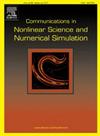Exact solutions and Bäcklund transformation for a generalized (3+1)-dimensional variable-coefficient Fokas-typed equation
IF 3.4
2区 数学
Q1 MATHEMATICS, APPLIED
Communications in Nonlinear Science and Numerical Simulation
Pub Date : 2024-12-31
DOI:10.1016/j.cnsns.2024.108567
引用次数: 0
Abstract
This paper is concerned with a generalized -dimensional variable-coefficient Fokas-typed equation, which is used to describe the interaction of nonlinear waves in ocean dynamics, shallow water waves, etc. By virtue of the Hirota bilinear method, the one-, two-, and three-soliton solutions are derived. Three kinds of bilinear Bäcklund transformation (BT) and the Bell-polynomial-typed BT are constructed based on the bilinear form. In addition, we obtain the lump solution and breather solution via the test function method. Three sets of variable coefficients are selected and the dynamic behavior of the corresponding lump solution is observed and analyzed. The main physics characteristics and spatial structure of these exact solutions are graphically discussed. Our results can be helpful in explaining certain related nonlinear phenomena.
求助全文
约1分钟内获得全文
求助全文
来源期刊

Communications in Nonlinear Science and Numerical Simulation
MATHEMATICS, APPLIED-MATHEMATICS, INTERDISCIPLINARY APPLICATIONS
CiteScore
6.80
自引率
7.70%
发文量
378
审稿时长
78 days
期刊介绍:
The journal publishes original research findings on experimental observation, mathematical modeling, theoretical analysis and numerical simulation, for more accurate description, better prediction or novel application, of nonlinear phenomena in science and engineering. It offers a venue for researchers to make rapid exchange of ideas and techniques in nonlinear science and complexity.
The submission of manuscripts with cross-disciplinary approaches in nonlinear science and complexity is particularly encouraged.
Topics of interest:
Nonlinear differential or delay equations, Lie group analysis and asymptotic methods, Discontinuous systems, Fractals, Fractional calculus and dynamics, Nonlinear effects in quantum mechanics, Nonlinear stochastic processes, Experimental nonlinear science, Time-series and signal analysis, Computational methods and simulations in nonlinear science and engineering, Control of dynamical systems, Synchronization, Lyapunov analysis, High-dimensional chaos and turbulence, Chaos in Hamiltonian systems, Integrable systems and solitons, Collective behavior in many-body systems, Biological physics and networks, Nonlinear mechanical systems, Complex systems and complexity.
No length limitation for contributions is set, but only concisely written manuscripts are published. Brief papers are published on the basis of Rapid Communications. Discussions of previously published papers are welcome.
 求助内容:
求助内容: 应助结果提醒方式:
应助结果提醒方式:


